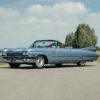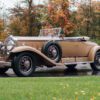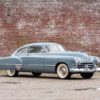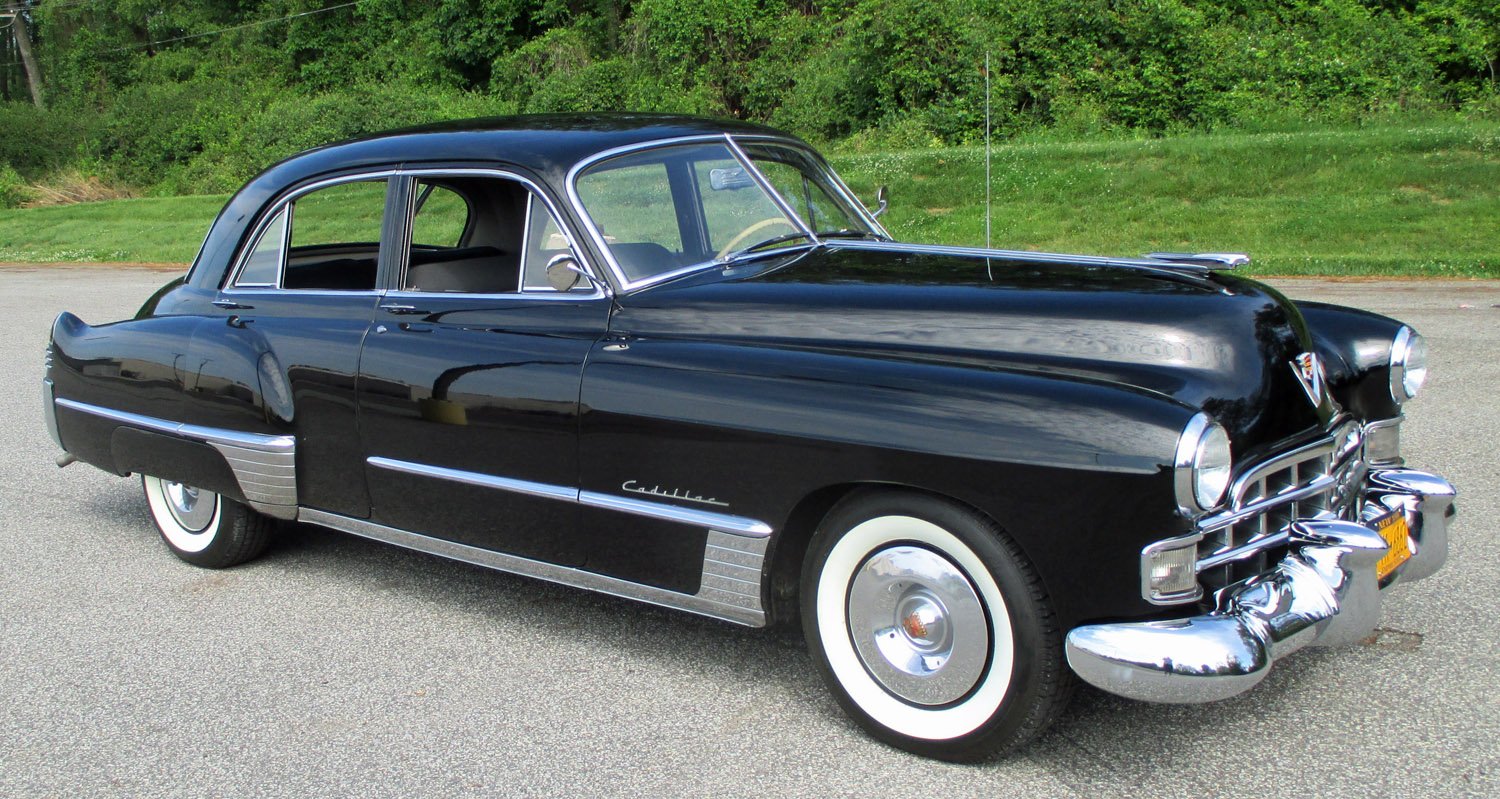Cadillac Models & History 1948
Thetrue postwar design history at Cadillac begins with the development of the 1948 model. As World War II drew to a close, there was a climate at Cadillac which had never existed before. Forces of unrest were afoot and a couple of key people, who might otherwise be relied upon to make important decisions, weren’t even there.

1948 Cadillac fin
The 1948-49 Cadillac was a dream come true — the dream of a young boy way back in 1920. Years before that, the boy’s Detroit socialite mother, Clara, had purchased the third Cadillac ever built, in 1903. Henry Leland, the husband of Clara’s close friend and founder of Cadillac, had loaned his own chauffeur to teach her how to drive. Since that time, there had been a long succession of new Cadillacs in the woman’s life. The boy had thus literally grown up with Cadillacs.

But there was something about Clara’s 1918 phaeton that awakened in the boy a deep appreciation for a well-designed machine. When his mother sold the phaeton after moving to California, the boy was heartbroken. He began making sketches of it, and from there expanded into the creation of his own automobile designs. Promising himself that one day he would design a Cadillac, that boy grew up to be one of the most influential automobile designers of all time: Franklin Q. Hershey.
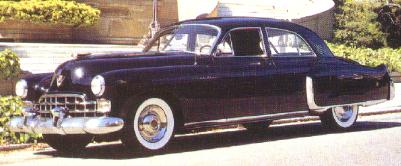
Hershey was initiated into the profession of automotive design at the Walter M. Murphy Body Company in Beverly Hills, California, where he created special automobile bodies for movie stars and millionaires. Later, he settled into a position with General Motors in Detroit. There, he developed a Bentley-style radiator for Pontiac, which quickly gained Hershey the recognition and support of Harley Earl, GM’s design czar. That was followed by the famed Silver Streak Pontiacs — a design theme that pulled the marque out of its commercial doldrums and became its trademark for two decades.
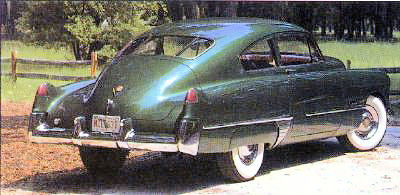
1948 Cadillac 2-door fastback
Upon his return from a stint in Germany, where he worked with GM’s Opel Division, Hershey was made head of the General Motors Advanced Design Studio at 40 Milwaukee Avenue in Detroit.
One day in the late Thirties, Earl received government permission through a friend to take some of his best designers to Michigan’s Selfridge Field to see a secret military aircraft. Designers Bill Mitchell and Frank Hershey were among the group. Though no one knew it then, this field trip was destined to become legendary in the history of automotive design.

Lockheed P38 Lightning
There on the runway, sat the thirteenth Lockheed P-38 Lightning, the twin-boomed aeronautical marvel that after some further development was going to set combat records in the coming war. Its radical design opened Mitchell’s, and especially Hershey’s, eyes to possibilities unthought of before — they were transfixed by the elegance of the plane’s design.
When the story of the ’48 Cadillac is told, the influence of the plane’s tailfins is usually the predominant theme. However the effect of the plane’s design encompassed much more than that. Mitchell said, “You have to understand the value of what we saw in that plane’s design. We saw that you could take one line and continue it from the cowl all the way back to the tip of the tail — that you could have one unbroken, flowing line.”
Hershey was also impressed with the plane’s aerodynamic flow, but when he got back to his studio he began experimenting with the line of the tailfin he had seen. He worked with that idea, but both he and Mitchell moved on to other design projects before they left GM to serve in the Navy during World War II. Even so, meeting up with the P-38 Lightning had cast a spell over all the designers who had seen it. This spell would carry through the long war to the introduction of the 1948 Cadillac almost a decade later — and beyond that into defining the design “flavor” of Cadillacs for years thereafter.

1948 Cadillac rear fins
Hall Hibbard and Kelly Johnson, the designers of the plane German fighter pilots would later label der Gabelschwanz — the fork-tailed devil — were quite modest about their influential design. The plane had evolved into its form because it had to accommodate two liquid-cooled GM Allison engines each with a General Electric turbocharger and Prestone radiators. Johnson was quoted in historian Bill Yenne’s book on Lockheed that, “There was a reason for everything that went into it, a logical evolution. The shape took care of itself. In design, you are forced to develop unusual solutions to unusual problems.” In other words, the plane’s design followed the functional requirements the military had laid down to the designers. It is one of those interesting ironies of history that Cadillac Motor Division manufactured precision assemblies for the Allison engines used on the P-38 during the war. Cadillac even made limited use of this fact in its wartime advertising.
Hershey returned to GM in 1944, and Earl put him in charge of the Cadillac Design Studio. The war was winding down, so Cadillac had to be made ready for a return to non-military production. To set the record straight, Mitchell, who had headed Cadillac design before going into the military, didn’t leave the Navy until about a year after Hershey. Even then, he didn’t stay long at GM because he was asked to run a private design firm that Harley Earl had earlier started with his sons. Both the 1948 and ’49 Cadillacs had been designed before Mitchell eventually returned to GM.
One other point must be made before continuing this story. In the late ’30s, Earl had traveled the 64 km to the University of Michigan in Ann Arbor to get a question answered. He wondered just what would be the optimum size for a less-than-full-size clay model of an automobile. Earl’s motivation was to save time, money, and space — but at the same time have his designers produce models that would give a true idea of a design concept’s full-size appearance. The University’s answer, after looking into the matter, was 3/8-scale.
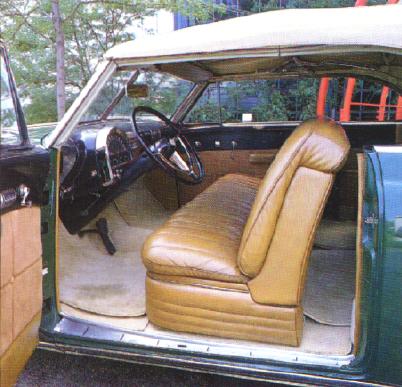
1948 Cadillac seats
The “Interceptor” proposal was the first design series to make use of the 3/8-scale model concept and to incorporate some of the ideas developed from the visit to see the P-38 Lightning. Some of the models sported an early version of the tailfin, others did not. All of them, however, were based on the single line flowing from the leading edge of the vehicle to the rear bumper. Some of the Interceptor models were even triple-prowed like the P-38, and otherwise borrowed heavily from the plane’s design.
Hershey remembers working on the clay models one day in the studio in the GM engineering building and adding tailfins to a particular model of that series. When Earl came in with Nick Dreystadt, one of the top executives, he saw them and told Hershey, “Take those things off!” Being the rugged individualist that he was, Hershey left the fins on and simply covered them with a drape. Earl came back a couple days later and said the same thing: “I told you to take those things off!” Hershey just covered the fins again.
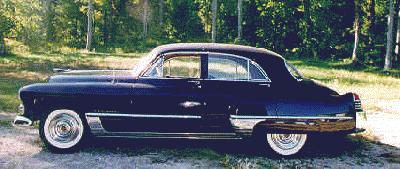
1948 Cadillac
Some time later, Dreystadt came into the studio, looked at the model, and said, “Thank God, you left the fins on the car! The top brass loves them!” Earl then encouraged Hershey to leave the fins on the models wherever he wished. Tailfins had gained a secure foothold in Cadillac design.
The Interceptor series was an interesting offshoot of Cadillac styling that was never introduced to the public. Actually, two full-sized running versions of the Interceptor concept were built shortly after the war. Partly due to their aerodynamic design, their performance on the GM test track was spectacular, Hershey remembers. The engineers were especially impressed.
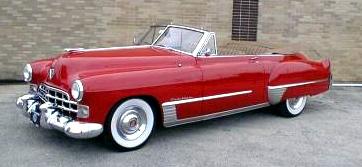
1948 Cadillac convertible
The problem was that when top management looked closely at the cars, they finally concluded that their design was just too advanced for the public. Harley Earl had once said, “A fundamental we have learned … is not to step too far at a time; but every now and then we take a risk.” To bring the Interceptor to production was deemed too great a risk. The Interceptor design concept thus went no further than the two prototypes that had been driven on the GM test track. Finally, they too were broken up.
The sad fact is that the Interceptor might well have become the 1948 Cadillac, but the design was judged to be too far ahead of its time. Earl therefore directed Hershey, as the head of Cadillac Design, to take a new tack — to start over. Because the 1946 and ’47 Caddys had been rehashes of the ’41 and ’42, it was concluded that Cadillac needed a fresh new beginning, one that would reinforce its leadership position of excellence of design.

1948 Cadillac rear fins
At this crucial point, a significant event occurred. There was labor trouble at GM and where in Detroit in the early postwar years, for that matter — effectively locking the design team out of its studio. During the work on the Interceptor, however, Hershey had bought a 60-acre farm about 48 km outside Detroit to be near the General Motors test track. In light of the lockout, he decided to move the Cadillac design team — including his master clay sculptor, Chris Kline — out to the farmhouse to continue design work in the basement. One of the guys even made a sign proclaiming this to be the Cadillac Design Studio (although the official designation of the team was “Special Car Design Studio”). Fortunately, there was much camaraderie in this makeshift facility — and even more hard work.
Thus did Hershey’s farmhouse become the birthplace of the befinned 1948 Cadillac. Franklin Q. Hershey, the man who just seven years later would give us the classic two-seater Ford Thunderbird, was also the man who gave us the ’48 Caddy — his boyhood dream of designing a Cadillac had come true. But it was more than that, for the ’48 would set a design standard that would influence Cadillac for years.
When most car buffs talk fins, they have a specific treatment in mind and point to the ’48 Cadillac as having the first. However, Bill Mitchell claimed that, strictly speaking, the ’48 was not exactly the first year for Cadillac tailfins. For example, he said, you can look at the 1937 Fleetwood Series Seventy-Five convertible sedan and see that there was a “fin-like” projection on the rear fender — even though that projection was fully chromed and was obviously a separate and distinct lamp housing attached to the fender.
But true fins are a sweep of the fender itself; sometimes the taillight is housed within it, sometimes not. The success of the ’48 Cadillac tailfin was how Hershey incorporated what Mitchell himself learned from the P-38. The fin was a continuation of the flow of the bodyline from the front to the rear of the car. It was as simple and as elegant as that, but Hershey alone had the talent and insight to put it together.
The ’48 Cadillac was an instant success with buyers. When dealers first saw it, however, they were apprehensive, and some were downright scared the public wouldn’t like it. But any negative opinions the dealers had were soon overshadowed by the public’s instant and massive demand for the car. The ’48 was the spirit of the P-38 Lightning on wheels — and it was there to be bought in any Cadillac showroom. With that beautiful line flowing through the body panels, climaxing in the elegant tailfins that gave the effect of making the car look longer, the sheer beauty and simplicity of the car’s body took many an onlooker’s breath away. The rounded bumpers and curved windshield only added to the car’s sleek styling. In 1948, Cadillac was the luxury car to own.
Everyone wanted to copy the Caddy in whatever way they could. Mail order houses did a brisk business selling tailfins that could be mounted on the rear fenders of Fords or Chevys. Design studios around the world adopted various forms of the fin for whatever car was being facelifted. Eventually one could see fins on everything from the Henry J to a Mercedes.
Even the grille of the ’48 was new, although it continued the distinctive wide cross-hatch theme. A delicate bow of chrome defined the top line of the grille, while the two inside horizontal bars ran outboard to become the upper and lower borders of the parking lights. The forward-sloping hood provided greater visibility, enhancing the low lines of the car, while the front fenders blended smoothly into the bodysides, becoming an integral part of the bodywork (rather than being “tacked on”).
In spite of its fresh new look, the ’48 Cadillac maintained much that was distinctive of the marque. The name in script, the goddess on the hood, “V” emblem with crest up front, eggcrate grille, massive “sombrero” wheel covers, distinctive body moldings, hardware and mascots by Chris Kline, and embryonic “Dagmar” bumper guards all shouted “Cadillac” loud and clear.
The Series Sixty-One and Sixty-Two, actually a bit shorter than the same models of the previous year, each offered a two-door fastback club coupe, or “Sedanet.” The almost-a-boattail coupes of 1948-49 were arguably the most beautiful postwar fastbacks ever built. The Sixty-Ones and Sixty-Twos differed only slightly in trim — no chrome rocker panel moldings or front fender stone shields for the Sixty-One, for example — but shared the same sheetmetal and 126-inch wheelbase. Hershey had indeed wrought some magic, because the 50mm-narrower cars were 50mm wider inside, where buyers really appreciated it.
The limited-production Fleetwood Series Seventy-Five conservatively carried on with the ’46 sheetmetal, amortizing the prewar 1941-42 dies used in the manufacture of this impressive 3454mm-long-wheelbase vehicle. Available in models which carried five people, to the nine-passenger Imperial, the Seventy-Fives were luxuriously finished both inside and out, striking awe into those who witnessed one lumbering down the boulevards of postwar America.
The design flagship of the line was the Sixty Special — the cream of the ’48 lineup. Hershey points out that the treatment of the stone guards ahead of the rear wheels on this model was a direct carry-over from the Prestone side radiators situated to the rear of the twin booms of the P-38. This inspired chrome treatment, the distinctive set of five chromed hashmark strips on the sail panel, the more elegant interior, and longer 3378mm wheelbase made the Sixty Special a much desired automobile, as it is even today.
Though retaining a narrow center pillar, the two-piece windshield on all models except the Seventy-Fives was curved, quite a novelty in 1948. And because the various models differed in height, Cadillac had to produce four different windshields for the model year.
Inside the ’48, instruments were clustered quite functionally in a deep pod under the dashboard line that carried through almost to the floor on both sides. Some automotive enthusiasts have called this a “rainbow” instrument panel because of its generous sweep. Functional ducts in the front doors circulated air to the side windows and the windshield, a forward-looking feature at the time.
Despite all the new styling features, the 150-horsepower L-head V-8 and Hydra-Matic automatic transmission were carried over virtually unchanged from 1941-47. The V-8 was tough, with a distinguished record for smoothness and longevity, and as good or better than anything offered by the competition. On the minus side, it was bulky and heavy. Maurice D. Hendry, in Cadillac, Standard of the World: The Complete History, described the engine’s performance and economy as “adequate.” The figures quoted were a top speed of 150 kilometres per hour, 0-96.6 km/h in 16.3 seconds, and fuel economy of 16.8 L/100km at 96.6 km/h (all figures with Hydra-Matic).
The ’48 Caddy didn’t get into production until late February 1948, and went on sale in dealer showrooms in March. The model year thus spanned a short nine months. Demand was higher than supply, but there was only time to build 52,706 cars for the ’48 model run.
HISTORICAL NOTES
1948 Cadillac Notes
- Division windows between front and rear seats were available on some Fleetwood models for limousine use.
- Commercial and business chassis were supplied to professional carmakers.
- John F. Gordon was general manager
- Edward N. Cole was chief engineer
- William Mitchell was chief designer (Cadillac Studio)
- Don E. Ahrens was general sales manager
- The Classic Car Club of American recognizes all 1948 Series 75 models as Classic Cars.
- The following models are recognized as Milestones by the Milestone Car Society:
- Series 61 coupe (sedanette)
- Series 62 coupe (sedanette)
- Series 62 convertible
- Series 60S Fleetwood Special sedan
- Cadillac production figures
1948 Automotive Notes
- Production increases to 3,910,213 cars
- Charles E. Wilson was president of GM
- Alfred P. Sloan, Jr. was chairman of the board at GM
- Chrysler Corp. passes Ford to become #2 to GM
- Ford Motor Company is in financial difficulty
- Hudson introduces their “Step-down” series with a low center of gravity
- Buick introduces Dynaflow torque-converter automatic transmission
- Pontiac offers Hydra-Matic transmission
- Willys introduces the Jeepster
- Ford develops a thermostatically controlled fan
- Borg-Warner promotes its automatic transmission
- Tucker operation is halted by the Securities and Exchange Commission
- B. F. Goodrich develops the tubeless tire
- Studebaker starts production in the Hamilton, Ontario plant
- George Mason is chairman of Nash to replace Charles W. Nash
- Top American Automobile Corporations for 1948
- Top model year production for 1948


